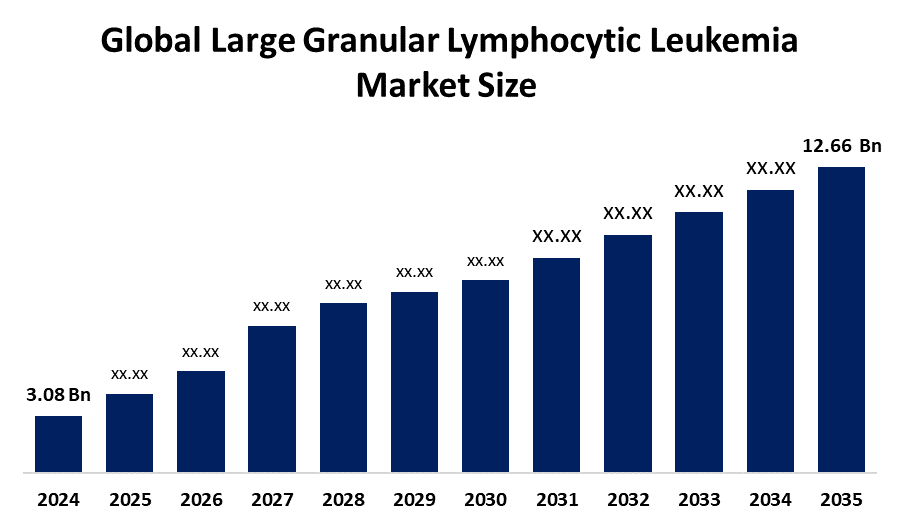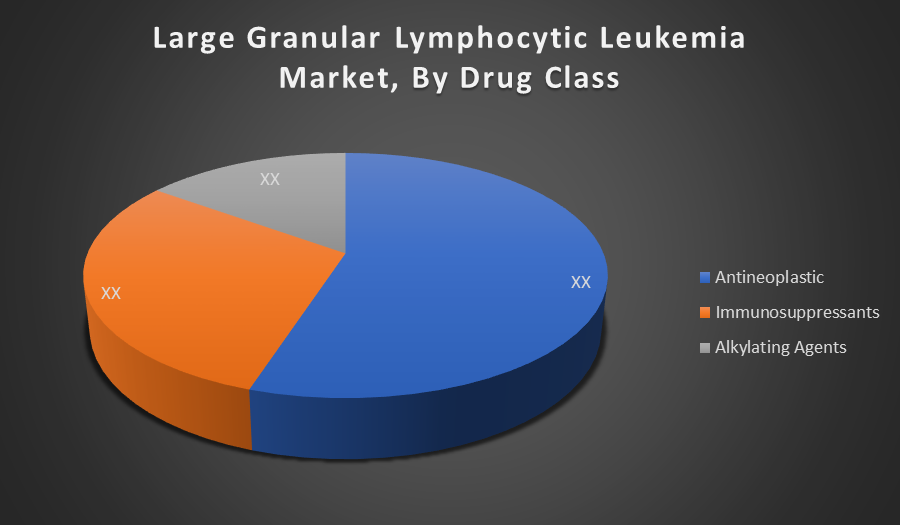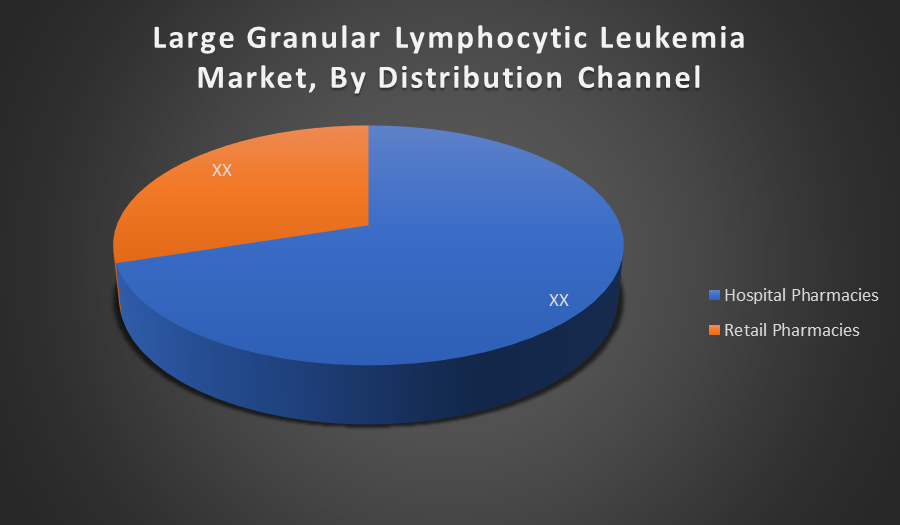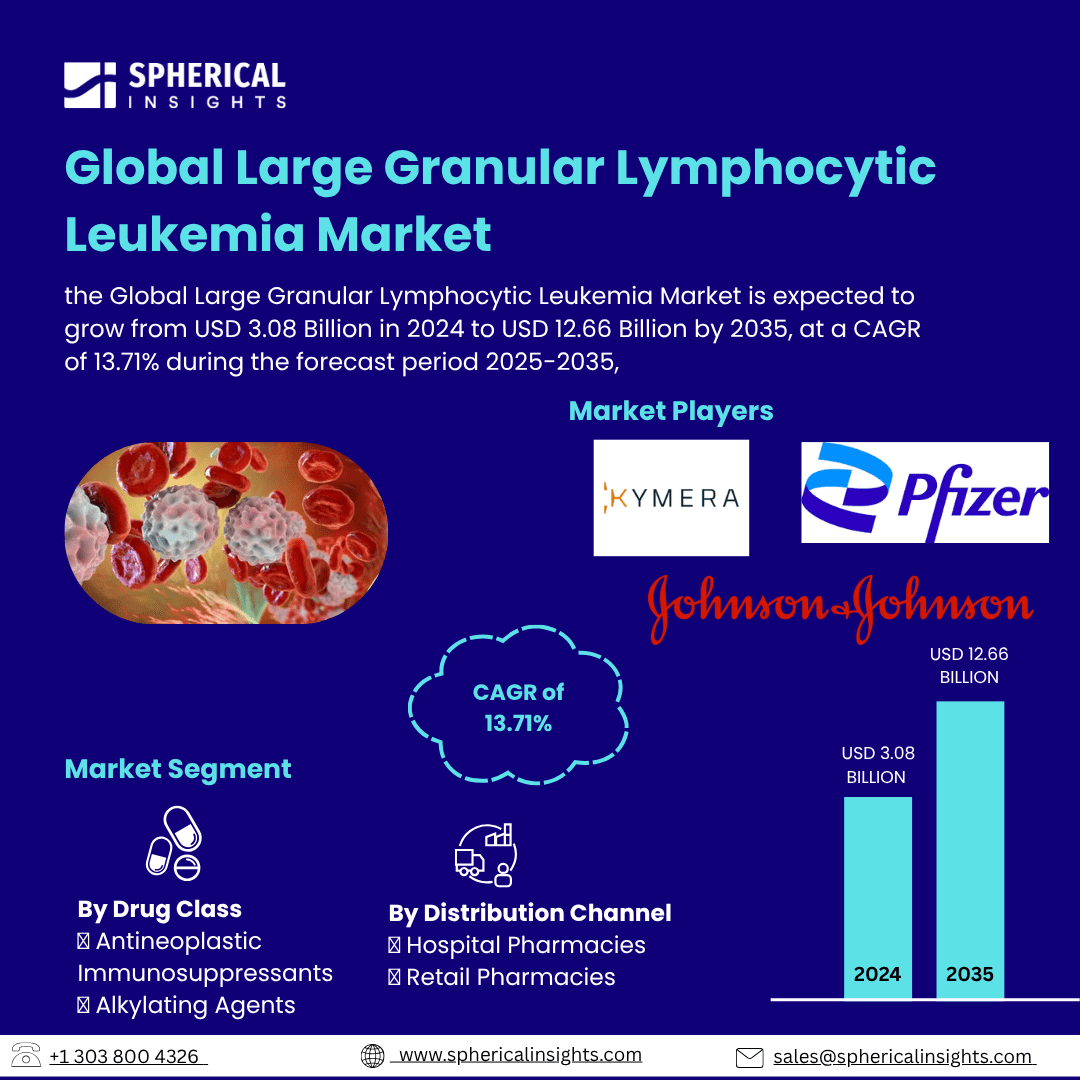- As per Spherical Insights & Consulting, The Global Large Granular Lymphocytic Leukemia Market Size is expected to grow from USD 3.08 Billion in 2024 to USD 12.66 Billion by 2035, at a CAGR of 13.71% during the forecast period 2025-2035, owing to the launch of new therapies in the market and the rise in the number of cases.
- The leading Large Granular Lymphocytic Leukemia Market Companies such as Kymera Therapeutics, Pfizer Inc., Johnson & Johnson Services Inc., Sanofi S.A., Merck KGaA, Amgen Inc., Novartis AG, Bristol Myers Squibb, Innate Pharma, AstraZeneca Plc., F. Hoffmann-La Roche AG, AbbVie Inc., GlaxoSmithKline plc, Teva Pharmaceuticals, and Others.
-

Large Granular Lymphocytic Leukemia Treatment Market: Understanding and Treatment Algorithm:
Large granular lymphocytic leukemia (LGLL) is a rare, chronic blood cancer characterized by the abnormal proliferation of large granular lymphocytes, a type of white blood cell. It often leads to immune system dysfunction, causing symptoms like anemia, infections, and autoimmune disorders, requiring targeted immunosuppressive or chemotherapy treatments.
Large Granular Lymphocytic Leukemia Diagnosis:
Diagnosis involves blood tests showing increased large granular lymphocytes, flow cytometry to identify abnormal cell markers, and bone marrow biopsy to confirm infiltration. Genetic testing for STAT3 or STAT5 mutations aids diagnosis. Clinical evaluation includes assessing symptoms like anemia, neutropenia, and recurrent infections.
Large Granular Lymphocytic Leukemia Treatment
Treatment typically involves immunosuppressive therapies such as methotrexate, cyclosporine, or corticosteroids to control abnormal lymphocyte growth. In severe cases, chemotherapy or targeted therapies may be used. Treatment aims to manage symptoms, improve blood counts, and prevent complications like infections and autoimmune disorders
Large Granular Lymphocytic Leukemia Epidemiology
The disease epidemiology covered in the report provides historical as well as forecasted epidemiology segmented by Total Diagnosed Incident Population of Large Granular Lymphocytic Leukemia, Gender-specific Diagnosed Incidence of Large Granular Lymphocytic Leukemia, Type-specific Diagnosed Incidence of Large Granular Lymphocytic Leukemia, Age-specific Diagnosed Incidence of Large Granular Lymphocytic Leukemia, Diagnosed Incident Population based on Primary Site of Large Granular Lymphocytic Leukemia, and Diagnosed Incident Population based on Histologic Classification of Large Granular Lymphocytic Leukemia Tumour in the global market covering North America, Europe, Asia-Pacific, Latin America, the Middle East, and Africa from 2024 to 2035.
Principal Insights
This section offers a global overview of large granular lymphocytic leukemia epidemiology in major markets worldwide.
Country Wise- Large Granular Lymphocytic Leukemia Multiforme Epidemiology
- The epidemiology segment provides Large Granular Lymphocytic Leukemia prevalence data and findings across key regions worldwide, including North America, Europe (Germany, France, Italy, Spain, and the United Kingdom), Asia-Pacific (including Japan), Latin America, the Middle East, and Africa.
Large Granular Lymphocytic Leukemia: Recent Developments:
- In November 2023, Bristol Myers Squibb announced that the FDA accepted for Priority Review its supplemental Biologics License Application for Breyanzi® (lisocabtagene maraleucel). The application sought to expand Breyanzi’s use for treating adults with relapsed or refractory chronic lymphocytic leukemia or small lymphocytic lymphoma after prior targeted therapies.
Large Granular Lymphocytic Leukemia Marketed Drugs:
Keytruda (pembrolizumab) is an anti-PD-1 monoclonal antibody that enhances the immune system’s ability to attack cancer cells. It is FDA-approved for several cancers, including head and neck squamous cell carcinoma, and is being investigated for hematologic malignancies due to its immune checkpoint inhibition.
Imbruvica (ibrutinib) is a Bruton’s tyrosine kinase (BTK) inhibitor used to treat chronic lymphocytic leukemia (CLL), mantle cell lymphoma, and other B-cell malignancies. It helps disrupt cancer cell growth and survival by blocking key signaling pathways.
Calquence (acalabrutinib) is a selective BTK inhibitor approved for CLL and small lymphocytic lymphoma (SLL). It works by blocking B-cell receptor signaling, leading to apoptosis of malignant cells.
Large Granular Lymphocytic Leukemia: Emerging Therapies
- BNT327: BNT327 is a bispecific antibody in late-stage clinical trials for LGLL. It simultaneously targets two immune checkpoints to boost T-cell activation and enhance anti-tumor response, aiming to improve treatment outcomes in patients resistant to conventional PD-1/PD-L1 inhibitors.
- Fingolimod: Fingolimod is an oral immunomodulatory agent under investigation for LGLL. It modulates sphingosine-1-phosphate receptors, reducing lymphocyte circulation and inflammation, potentially controlling abnormal lymphocyte proliferation seen in LGLL.
- Magrolimab: Magrolimab is an anti-CD47 monoclonal antibody designed to block the “don’t eat me” signal on cancer cells, enhancing macrophage-mediated phagocytosis. It is being explored in hematologic malignancies, including LGLL, to improve immune clearance of malignant lymphocytes.
- Pirtobrutinib: Pirtobrutinib is a next-generation, non-covalent BTK inhibitor in clinical development for refractory lymphoid malignancies. It overcomes resistance mechanisms seen with earlier BTK inhibitors and shows promise in LGLL patients with relapsed disease.
Large Granular Lymphocytic Leukemia Market Outlook
- The global large granular lymphocytic leukemia market involves the development, production, and sale of therapies and diagnostics for LGLL, a rare chronic blood cancer marked by abnormal large granular lymphocyte growth. It includes immunosuppressive drugs, targeted treatments, and emerging biologics to improve patient care worldwide.
- Key drivers of the global large granular lymphocytic leukemia market include rising LGLL prevalence, growing awareness, advancements in targeted therapies, increased R&D investments, and expanding healthcare infrastructure. Additionally, improved diagnostic technologies and unmet medical needs for effective treatments are accelerating market growth globally.
- Opportunities in the market include the development of novel targeted therapies, expansion into emerging markets, collaborations for innovative drug research, and advances in personalized medicine. Increasing clinical trials and growing patient populations also offer potential for market growth and new treatment options.
- Governments worldwide are supporting LGLL research through funding, regulatory fast-tracking, and awareness programs, aiming to improve diagnosis, treatment access, and encourage innovation in therapies for better patient outcomes.
- Challenges include limited awareness, diagnostic difficulties, treatment resistance, and a lack of approved targeted therapies for Large Granular Lymphocytic Leukemia.
- The market is projected to grow steadily due to rising disease prevalence and ongoing therapeutic innovations.
Large Granular Lymphocytic Leukemia Market Segmentation
By Drug Class:
- Antineoplastic
- Immunosuppressants
- Alkylating Agents

The Antineoplastic drug class dominates the Global Large Granular Lymphocytic Leukemia market share due to its targeted action against cancer cells, higher efficacy, and growing adoption in treatment protocols. Additionally, hospital pharmacies lead distribution, driven by the need for specialized administration and monitoring of these complex therapies.
By Distribution Channel:
- Hospital Pharmacies
- Retail Pharmacies

The Hospital Pharmacies segment dominates the distribution channel in the Large Granular Lymphocytic Leukemia market due to the requirement for specialized handling, administration, and monitoring of complex therapies. Hospitals provide comprehensive care, including infusion services and patient management, making them the preferred choice for LGLL treatment distribution.
Regional Segment Analysis of the Large Granular Lymphocytic Leukemia Market
North America holds the largest share in the Large Granular Lymphocytic Leukemia market due to its advanced healthcare infrastructure, higher disease awareness, and significant R&D investments. The presence of major pharmaceutical companies and established regulatory frameworks supports rapid drug approvals and clinical trials. Additionally, better diagnostic capabilities and access to cutting-edge therapies contribute to higher patient diagnosis and treatment rates. The strong reimbursement environment and well-established hospital networks further fuel market growth, making North America a dominant player in the LGLL market.
The Asia-Pacific region is the fastest-growing market for LGLL, driven by increasing healthcare spending, improving diagnostic facilities, and rising awareness about rare hematologic disorders. Expanding healthcare infrastructure, coupled with growing government initiatives to combat cancer and hematologic diseases, propels market growth. Additionally, the increasing prevalence of LGLL, a large patient pool, and the growing adoption of novel therapies contribute to rapid market expansion. Emerging economies such as China and India are seeing increased clinical trial activities and collaborations, creating opportunities for new drug launches and improved treatment access in this region.
Large Granular Lymphocytic Leukemia Market Key Companies
- Kymera Therapeutics
- Pfizer Inc.
- Johnson & Johnson Services Inc.
- Sanofi S.A.
- Merck KGaA
- Amgen Inc.
- Novartis AG
- Bristol Myers Squibb
- Innate Pharma
- AstraZeneca Plc.
- F. Hoffmann-La Roche AG
- AbbVie Inc.
- GlaxoSmithKline plc
- Teva Pharmaceuticals
- Others
Large Granular Lymphocytic Leukemia Therapeutics Market Report Scope
- The Large Granular Lymphocytic Leukemia therapeutics market report provides a detailed overview, covering its causes, symptoms, disease progression, and existing treatment options.
- Detailed insights into Large Granular Lymphocytic Leukemia’s epidemiology and therapeutic approaches are included.
- Additionally, a comprehensive review of existing and emerging Large Granular Lymphocytic Leukemia therapies is provided, including an evaluation of new treatments expected to influence the current Large Granular Lymphocytic Leukemia treatment market landscape.
- The report includes a detailed review of the Large Granular Lymphocytic Leukemia therapeutics market, both historical and forecasted, highlighting the global drug reach.
- The Patient-Based Large Granular Lymphocytic Leukemia Market Forecasting report offers valuable insights into trends shaping the global Large Granular Lymphocytic Leukemia market, helping to develop effective business strategies.
Large Granular Lymphocytic Leukemia Treatment Market Report Insights
- Forecasting Market Trends Based on Patient Data and Disease Rates
- Large Granular Lymphocytic Leukemia Therapeutic Approaches in Large Granular Lymphocytic Leukemia
- Review Of Drugs in Development for Large Granular Lymphocytic Leukemia
- Market, Growth, and Trends in Large Granular Lymphocytic Leukemia
- Market Opportunities in Large Granular Lymphocytic Leukemia Treatment
- Effects Of Future Therapies on Large Granular Lymphocytic Leukemia Treatment.
Large Granular Lymphocytic Leukemia Treatment Market Report Key Strengths
- 15 Years Large Granular Lymphocytic Leukemia Market Forecast
- Global Coverage
- Large Granular Lymphocytic Leukemia Epidemiology Segmentation
- Key Cross Competition
Large Granular Lymphocytic Leukemia Treatment Market Report Assessment
- Present Practices in the Large Granular Lymphocytic Leukemia Treatment Market
- Review of Investigational Large Granular Lymphocytic Leukemia Drugs
- Attractiveness of the Large Granular Lymphocytic Leukemia Drug Market
- Large Granular Lymphocytic Leukemia Market Drivers
- Large Granular Lymphocytic Leukemia Market Barriers
- SWOT
- Attribute Analysis
Market Segment
This study forecasts revenue at the global, regional, and country levels from 2020 to 2035. Spherical Insights has segmented the large granular lymphocytic leukemia market based on the below-mentioned segments:
Global Large Granular Lymphocytic Leukemia Market, By Drug Class
- Antineoplastic
- Immunosuppressants
- Alkylating Agents
Global Large Granular Lymphocytic Leukemia Market, By Distribution Channel
- Hospital Pharmacies
- Retail Pharmacies
Global Large Granular Lymphocytic Leukemia Market, By Regional Analysis
- North America
- Europe
- Germany
- UK
- France
- Italy
- Spain
- Russia
- Rest of Europe
- Asia Pacific
- China
- Japan
- India
- South Korea
- Australia
- Rest of Asia Pacific
- South America
- Brazil
- Argentina
- Rest of South America
- Middle East & Africa
- UAE
- Saudi Arabia
- Qatar
- South Africa
- Rest of the Middle East & Africa






